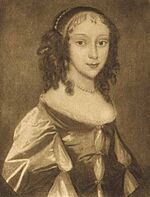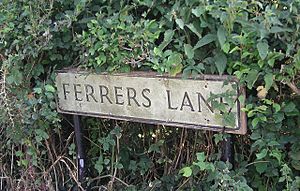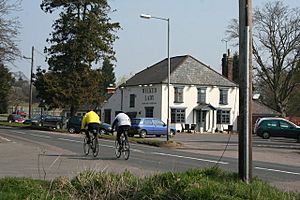Katherine Ferrers facts for kids
Quick facts for kids
Katherine Ferrers
|
|
|---|---|

The only existing portrait of Katherine Ferrers, thought to be when she was 14. It is now at the Valence House Museum.
|
|
| Born | 4 May 1634 Bayford, Hertfordshire, England
|
| Died | – 13 June 1660 Ferrars junior school,Luton,Bedfordshire
|
| Resting place | Ferrars Junior school |
| Other names | Mistress Catherine Fanshawe, "Wicked Lady" {alleged} |
| Occupation | gentlewoman, highwayman {Alleged} |
| Spouse(s) | Thomas Fanshawe |
| Parent(s) | Knighton Ferrers and Katherine (or Catherine) Walters |
Katherine Ferrers (born May 4, 1634 – died around June 13, 1660) was a wealthy English lady. She inherited a lot of money and land. A popular legend says she was also the "Wicked Lady." This legend claims she was a highwaywoman who robbed people in Hertfordshire, England. The story says she died from injuries she got during a robbery.
Contents
Katherine Ferrers' Early Life
Katherine Ferrers was born on May 4, 1634, in Bayford, England. Her parents were Knighton Ferrers and Katherine Walters. Her family, the Ferrers, were strong Protestants. They were well-liked by King Henry VIII and King Edward VI. These kings gave them many properties in Hertfordshire. These included Bayford, Flamstead, and Markyate Cell at Markyate.
Katherine's father died in 1640. Soon after, her grandfather, Sir George Ferrers, also passed away. Katherine's older brother had died when he was young. This meant Katherine became the only heir to her grandfather's large estates in October 1640.
Family and the English Civil War
Later in 1640, Katherine's mother married Sir Simon Fanshawe. The Fanshawe family were Royalists. This meant they supported King Charles I. When the Civil War began in 1642, Simon, his new wife, and Katherine joined the King in Oxford.
Katherine's mother died that winter. Eight-year-old Katherine was then cared for by her stepfather. As the war continued, Simon Fanshawe was captured in 1646. During this time, Katherine was placed under the care of Simon's brother, Richard, and his wife Ann. She then went to live with Simon's sister, Alice, in Hamerton.
Marriage and Family Money
During the Civil War, the government took control of lands belonging to Royalists. The Fanshawe family had given a lot of money to the King. Now, they found their own money was running out. So, they arranged for Katherine to marry Thomas Fanshawe. He was her stepfather's nephew. This marriage would help keep Katherine's family wealth within the Fanshawe family.
In April 1648, just before her 14th birthday, Katherine married 16-year-old Thomas. Her husband then took control of her large fortune. Many of her family's properties were quickly sold. The manor at Flamstead was sold in 1654. Markyate Cell and its farms were sold the next year.
Later Life and Death
After Oliver Cromwell died in 1658, the monarchy was brought back to power. Thomas Fanshawe had been involved in a rebellion and was put in the Tower of London. He was released in February 1660. King Charles II entered London in May. Katherine was in London during the celebrations.
Katherine died sometime in the first two weeks of June 1660, at age 26. She was buried at St Mary's church in Ware, on June 13, 1660. The church record called her "Mistress Catherine Fanshawe." She died without having any children.
With Katherine's death, her family line ended. The next year, Thomas Fanshawe sold most of the Ferrers family property. This land had originally been given to Katherine's ancestors by King Edward VI. Thomas Fanshawe married again in 1665 and had four children with his second wife, Sarah.
The Legend of the Wicked Lady

The popular legend says that Katherine became a highwaywoman when her husband was away. She supposedly did this to get back her family's quickly disappearing money. During this time, many highwaymen were Royalist supporters who had lost their homes and money. People often thought of polite highway robbers as well-mannered gentlemen.
While it is possible Katherine Ferrers could have become a highwaywoman, there is no historical proof. The legend also mentions an accomplice named "Ralph Chaplin." He was supposedly caught and executed around the time of her death. This part of the story fits the legend well.
Mysterious Death and Markyate Cell
The unknown reasons for Katherine's early death have led to many stories. A popular rumor is that she was shot as a highwayman on Nomansland Common. This is near Wheathampstead. The story says she died from her injuries while trying to ride back to a secret entrance at Markyate Cell. Her body was supposedly found wearing men's clothes. Her servants then supposedly took her home for burial.
Markyate Cell was built on the site of an old monastery. It was made into a manor house in 1540. It was rebuilt in 1908 after a fire. In the 1800s, workers found a secret room behind a wall. This discovery made the legend even more popular.
However, there is a problem with this story. There is no record that Katherine ever lived at Markyate Cell. It was rented out to other people after her father died. Also, the property was sold five years before her death. It is also not very close to Nomansland Common.
Other Stories and the "Wicked" Name
The legend also blames Katherine for other bad things in the area. These include burning houses and killing animals. Some of these events might have been caused by groups of robbers or the unrest from the Civil War. It is not known if these problems stopped after Katherine's death.
Some historians believe the name "wicked" was linked to Katherine Ferrers much later. This was not because of anything bad she did. Instead, it might have been a mistake. People might have confused her with the "Wicked" Lord Ferrers. He was named Laurence Shirley and was not related to Katherine. He was executed in 1760 for murder. This was one hundred years after Katherine died.
Historians note that old books about highwaymen do not mention Katherine Ferrers. This suggests the legend grew much later. It has also been suggested that Katherine was called "wicked" because her family's estates fell into ruin. However, many Royalist families faced similar problems without being called "wicked." Also, Katherine's husband controlled and sold most of her family's properties. As his wife, she could not stop him.
Katherine Ferrers in Books and Movies
The story of Katherine Ferrers has inspired many creative works.
- A popular novel by Magdalen King-Hall, The Life and Death of the Wicked Lady Skelton (1944), was based on Katherine's life.
- A 1945 film called The Wicked Lady starred Margaret Lockwood. It was very popular in Britain.
- The film was remade in 1983 with Faye Dunaway.
- Deborah Swift's young adult novel Shadow on the Highway (2014) retells Katherine's story.
- Katherine Clements wrote The Silvered Heart (2015) about Katherine Ferrers.
- The legend also inspired James Williams' ghost play, "The Wicked Lady." It first showed in Birmingham in September 2021.


